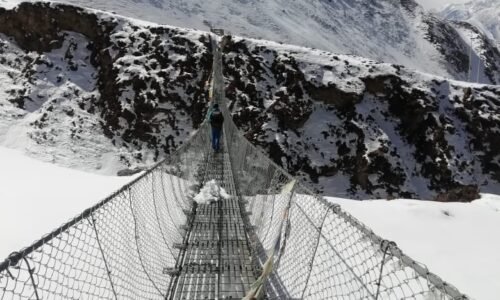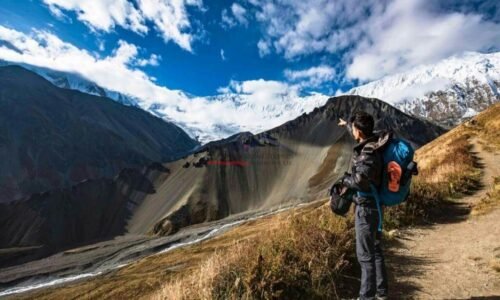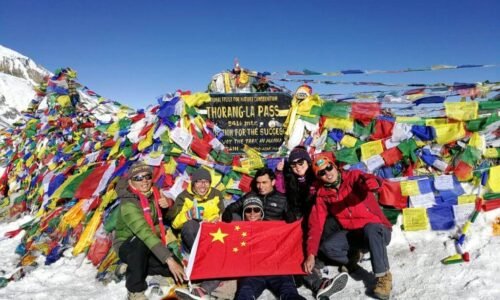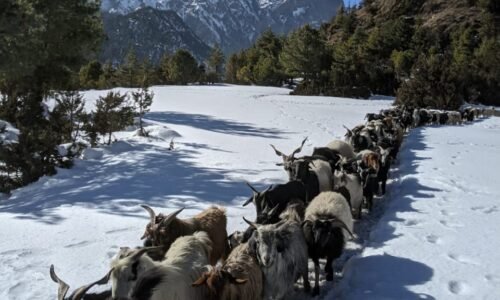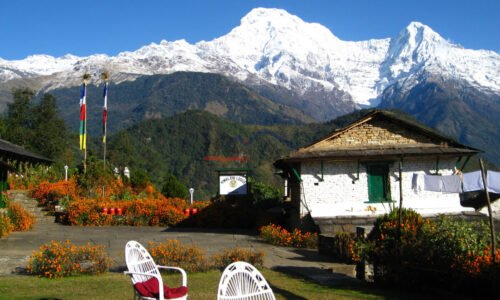-
Duration 16 Days
-
Difficulty Strenuous
-
Max Elevation 5,416m
-
Accommodation Tea House
-
Best Season Sep-Nov and Feb-April

A very pleasing trek pursue the trail that will take you from lush meadow to wooded pine forests to barren countryside and magnificent visions of the Annapurna mountain range. The Annapurna Circuit Trek is also recognized as Nepal’s classic Himalayan trek which overdue more variation than any other similar length trek, taking us through virtually every type of terrain that Nepal has to propose.
Annapurna Circuit Trek is offering an amazingly diverse and inspiring trek in Nepal since the 1980s. Undoubtedly it is the likable region for the adventure tourist. Aside from the cultural variety as well as the different shape of flora and faunas, it is the trendiest trekking due to its dramatic background of the Himalayas and democratic different communities. The wild animals and birds like Snow Leopards, Mountain Goat, pheasant and so outward are also the things of allure.
The trek passes through two distinct river valleys surround the Annapurna range. Beshisahar in the Marshyangdi river valley from where the trek to Annapurna circuit trek starts and ends up in the Kali Gandaki ravine. Annapurna Circuit Trek starts from lower elevation of Besisahar and moves up to the higher elevation to adapt our body to make good health for the higher elevation to boost very moderately. Peak sickness is common among the pupil trekkers.
What time will be appropriate for Annapurna Circuit Trek
June through mid-September is the monsoon season in Nepal. That’s when most of the rain falls and rock and Landslides are most likely to appear.
The autumn, between mid-September and mid-November and the spring, between mid-March and mid-April, are the appropriate time for trekking. Weather is usually clear but still wet only in September when the leeches are an annoyance at lower elevations. Since the temperature is tolerable which offers stunning views without any impediment. Spring collects beautiful flowers, plants, and rare animals. Walking is also very much appropriate during this season.
Beyond this, if you want perfect time for the Annapurna Circuit trek then October month is best among all. During this month the weather will be neither rainy nor cold just dry and clear skies.
Trip Highlights
- Classic trek on ancient trade routes.
- Probe the cultural and natural beauty of the Annapurna region.
- Take a tour Hindus and Buddhist holiest Muktinath temple.
- Eye-catching views of Mt. Manaslu, Pisang peak, Annapurnas, Himalchuli peak and fishtail mountain.
- Thorong La pass (5,416m.) - one of the longest pass in the world.
- Hike along the world deepest canyon- Kali Gandaki River.
- Soar the Marshyangdi valley.
- Probe Stunning distinct villages.
- Sunrise at Poonhill with panoramic mountain views.
- Excursion in UNESCO world cultural heritage sites of Kathmandu Valley.
Annapurna Circuit Trek ~ Itinerary
Day 1
Arrival in kathmandu (1350m)
Somebody from our company will pick you up with private transport from Kathmandu airport with your name card. Then, they will drive you to the hotel and introduce you to your trekking guide, prepare all the equipment for trekking, and you will stay overnight in Kathmandu.
Day 2
Kathmandu to Besisahar (830m).
Along the journey, witnessing some spectacular scenery including white mountains, green hills, rivers, and hamlets, we will take you to Besisahar, which is approximately 6-7 hours away from Kathmandu.
Day 3
Besi Sahar to Bahundanda (1,430m).
We start the day by trekking down a steep slippery trail past bowl-shaped rice terraces to a small hot spring. Most of the rest of the day, we hike along the bank of the river and its adjacent waterfalls. From Jagat, we hike up to Chamje. This trek takes approximately 6-7 hours.
Day 4
Bahundanda to Chamche (1,410m).
Today, we will make the 940m hike up to Bagarchap through bamboo and rhododendron forests on a trek high above the riverbank, offering beautiful shots. Bagarchhap is the first village on the trek with typical Tibetan architecture, comprising closely spaced stone houses with flat roofs piled high with firewood. This trek takes approximately 7-8 hours.
Day 5
Chamche to Bagarchhap (2,160m).
Today, we will embark on a 940m hike up to Bagarchap, passing through bamboo and rhododendron forests on a trail high above the riverbank, offering beautiful scenery. Bagarchhap is the first village on the trek characterized by typical Tibetan architecture, featuring closely spaced stone houses with flat roofs piled high with firewood. This trek takes approximately 7-8 hours.
Day 6
Bagarchhap to Chame (2,170m).
We first trek along the south bank of the river, climbing to the Syal Khola, famously known as “the river of jackals,” at 2,210m. From there, the trek crosses several landslides as it ascends uphill through a jungle of walnut tree forest and past apple orchards until we arrive at Chame. This trek takes approximately 6-7 hours. We stay overnight at a mountain tea house.
Day 7
Chame to Pisang (3,190m).
Today, we first trek up to Telekhu (2,845m) and continue with a long, pleasant, and mostly level hike through the alpine jungle forest to Brathang (2,950m). Then, crossing the Marsyangdi River via a long suspension bridge at 3,080m, we make a long, gentle hike over a ridge through blue pine forests. After this, the trek will be reasonably level as it heads toward Pisang. This trek takes approximately 5 hours. We stay overnight at a tea house lodge.
Day 8
Pisang to Manang (3,540m).
Today, our trek slowly and spectacularly climbs up to the large village of Braga, which is Tibetan-style, situated at 3,470m. We then hike on through a very arid countryside, dominated by weird cliffs of yellow rock eroded into dramatic pillars alongside the trek, to reach today’s destination, the village of Manang. This trek takes approximately 5-6 hours. We stay at a tea house.
Day 9
Rest Day.
Today is an acclimatization day though we could do a side-trek to, for instance, Khangsar.
Day 10
Manang to Ledar (4,250m).
Trekking slowly upwards to Thorung La we leave the large trees behind and see vegetation consisting mainly of scrub juniper and alpine grass and we hike past meadows where horses and yaks graze. After 1 hour of hiking Yak Kharka (meadow), we arrive at Letdar. (4/5 hrs trek).
Day 11
Ledar to Thorong Phedi (4,450m).
It is easy trekking day to get used to the altitude before we hike over the highest point on the trek. From Letdar we will continue to trek up along the east bank of the Jarang Khola to Thorong Phedi, a rock-strewn meadow surrounded by vertical 4,420m cliffs where blue sheep and even snow leopards can sometimes be seen. (3/4 hrs trek).
Day 12
Thorong via Thorong La (5,416m) to Muktinath (3,800m).
With its traditional prayer flags and stone cairn, the views are outstanding. The trek becomes less steep as we enter grassy fields and hike across meadows to our destination of Muktinath, place of Nirvana, home to the Muktinath Temple as well as several monasteries. Another attraction nearby is the Jwala Mai Temple and this contains a spring and an eternal flame fed by natural underground gas. (9 hrs trek).
Day 13
Muktinath to Jomsom (2,665m).
We make a 1 km hike through meadows, streams and fruit orchards down to Kagbeni, a fascinating medieval village infused with Tibetan culture. In addition, the hike from Kagbeni to Jomsom can get windy in the afternoon, it’s best done in the morning. (6 hrs trek).
Day 14
Jomsom to Pokhara.
We fly to Pokhara. Here you might consider a paragliding flight with or without an instructor.
Day 15
Pokhara to Kathmandu.
We return to Kathmandu from Pokhara then stay overnight at Kathmandu.
Day 16
Final Departure
Your airport time we will arrange private transportation with our company rules.

